

According to Einstein's General Theory of Relativity,space can be thought of as a surface, or a plain, and objects with massdistort the surface of space. "Imagine taking a sheet of tough plasticand stretching it tightly over a large, rigid frame... Imagine placinga heavy lead ball on the sheet of stretched plastic. The lead sphere willweigh the plastic down, distorting and warping it. If you rolled a ballbearing across the plastic, it would follow a path that carried it nearer the lead sphere than it would have otherwise gone." (Hazen & Trefil,168) The lead sphere represents a star, or any massive object in space,and the ball bearing not only represents objects moving through space,but it also helps us to envision how General Relativity views motion andhow that motion is effected in space.
Einstein believed that if two masses had a mutual attraction it wasbecause they were close enough to be affected by each others warp in space-time.Does this idea of warped space contradict Newton's thoughts on the forceknown as gravity? Both Newton and Einstein were explaining how motion iseffected in space, just in different ways. Newton's laws quantify the mechanicsbehind the force that bodies have on each other. Einstein disposes of thenotion of a force and explains the effects as curvature of space. "Newtonianthinking says that galaxies that are billions of light years apart effecteach other because of gravity; Einstein says that they affect each otherbecause of how their masses curve space-time. Newton's laws are descriptive,they tell what happens, Einstein's theories attempt to tell how." (5)
The Newtonian view of motion is that an object moves in a straight linein space unless a force acts upon it. Einstein interpreted the geographyof space and motion of objects a little differently than Newton. For Newton,motion was along curved lines in a flat space. Einstein theorized thatmotion was along straight lines in a curved, or warped space. Einsteinbelieved that objects with mass warped the space in their vicinity, justas the lead ball warped the space in its vicinity. "The relativistic interpretationof the solar system, then, is that the sun warps the space around it andthe planets move around in this space like marbles rolling around the insideof a bowl." (Hazen & Trefil, 168)
 space
space  time
time 
Now, imagine the lead sphere gaining mass without gaining size. As theball gained mass it would further distort and warp the sheet of plastic."Relativity predicts that when a large enough mass is concentrated in asmall enough volume, it distorts the space around it so severely that apart of space wraps itself up and leaves the rest of normal space behind."(Hazen & Trefil, 171) When a large mass becomes so "concentrated,"and warps and distorts space that heavily, it is said to have formed ablack hole.
Black Holes
A black hole is the end result of the death of a very massive star.When a star with a mass three times or more than that of our sun dies,all of the stars mass becomes squeezed into a single point. At that singlepoint, it is theorized that both space and time stop. That point at thecenter of a black hole is called a singularity. When a star is burning,it holds its shape because the outward force of its heat radiation balancesthe force of its gravity. When very massive stars stop burning, the forceof gravity that is working against the star is so strong that the leftover mass of the dead star can no longer support itself and, " the starquickly shrinks in size until finally it is crushed, presumably to thesize of a pinhead, then to the size of a microbe, and finally to a realmof size smaller than ever measured by humans. At this point, accordingto theory, there is infinite density. This point is called the black holesingularity." (Hewitt, 713-14)
When a star's mass is collapsing into a singularity, its volume decreasestowards zero. As the volume decreases towards zero, the density, inversely,rises towards infinity. So a singularity, because it has no volume, isthought to have infinite density.
If a black hole is considered to be the "end" of space, it is also consideredto be the end of time. Physic's laws can be used to describe the gravitationalpull that a black hole has on objects around it. However, the laws of physicsbreak down at the singularity, where space and time do not seem to existas we know them. According to Stephen Hawking, as a black hole singularityforms, "it would be an end of time for the collapsing body" (Hawking, 88).Space-time does not exist at the singularity. In order to understand the idea of space-time, it is important to think of space geometrically. Inthe General Theory of Relativity, space is shown as a horizontal surfaceplain, and time is expressed vertically. This is what is referred to asfour dimensional space-time (the three physical dimensions and the fourthdimension of time). Stephen Hawking theorized that a black hole singularityis analogous to what the Universe was before the Big Bang, when all matterwas compressed into a very tiny point. Time, for us, began when that singularityexpanded, creating four dimensional space-time.
Within a certain distance of the black hole's singularity, the gravitationalpull is so strong that nothing can escape. That distance is call the EventHorizon. The Event Horizon is not a physical boundary but the "point-of-no-return"for anything that crosses it. When scientists refer to the size of a blackhole, they are referring to the size of the Event Horizon. The more mass the singularity has, the larger the gravitational pull, the larger theEvent Horizon. (5)
 (5) (5)
(5) (5) 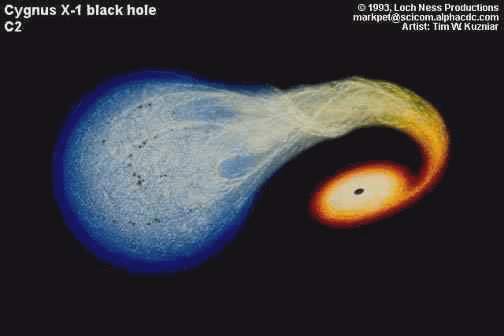
A common misconception is that nothing can escape the intense gravityof black holes, that the Universe will eventually be "sucked in." It is true that the gravitational pull of a black hole is so great, thatneither light, nor any other kind of electromagnetic radiation, can escapeonce it is caught within the Event Horizon. However, stars and planetsat a safe distance will circle around a black hole, much like the motionof the planets around the Sun. The gravitational force on stars and planetsorbiting a black hole is the same as when the black hole was a star becausegravity depends on mass, not on size. A black hole has the same mass asit did when it was a star, its mass is just highly compressed.
The Birth of a Black Hole - The Death of a Star
In order of understanding the "birth" of a black hole, it is importantto first understand the life cycle of a star. A star is created when alarge cloud of gas in space, mainly hydrogen, begins to collapse into itselfbecause of the force of gravity. As the gas cloud collapses the atoms arepushed closer together. The atoms collide more frequently as they are pushedcloser together, these atomic collisions are what creates heat. Eventuallythe gas gets so dense and warm, that nuclear fusion begins. Young starsare mainly hydrogen, as fusion occurs it converts hydrogen to helium, withenergy left over. This left over energy is the star's radiation, its heatand light. When most of the hydrogen has been converted to helium, a newnuclear reaction begins that converts the helium to carbon, with the leftover energy released as radiation. This process continues converting thecarbon to oxygen, to silicon, to iron. Nuclear fusion stops at iron. (5) In this process, a huge amount of heat energy is generated. All the whilethat this process is taking place, gravity is working against the star, trying to collapse the burning sphere of gas.
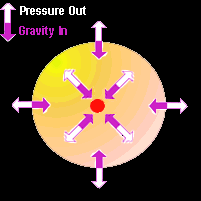 (9)
(9)
While a star is burning, the heat pressure in the star pushes out andbalances the force of gravity. When the star's fuel is spent, and it stopsburning, there is no heat energy left to counteract the force of gravity.Whatever material is left collapses in on itself. Stars about the samesize as the Sun become white dwarfs, which glow from left over heat. Starsthat have about 3 times the mass of the Sun compact into neutron stars.A star with mass greater than 3 times the mass of the Sun collapses intoa single point. (5) That point is a black hole, "the ultimate triumph ofgravity, the ultimate defeat of a star." (Hazen & Trefil, 139)
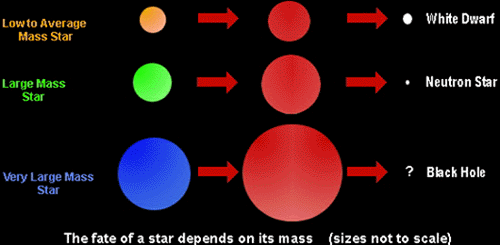 (9)
(9)
How We Detect Black Holes?
One of the best methods Astronomers use to detect black holes is tostudy X-ray binary systems. These systems consist of a visible star inclose orbit around an extremely compact, X-ray emitting companion. The companion pulls matter away from the visible star into an accretion diskthat produces vast fluxes of X-rays that vary in intensity within a second.(9) Astronomers have found that only a black hole is small enough and massive enough to create such intense X-ray activity.
A black hole does not burn and it does not generate heat. Heat is thethermal energy that matter contains, it is the motion of its particles.(5) Any matter that gets sucked into a black hole takes its thermal energywith it. The intense gravity from a black hole pulls in dust particlesfrom a surrounding cloud of dust or from a nearby star. This gravitationalpull takes place with an extreme amount of force. As particles fallinto a black hole, they speed up and heat up. The violent descent of matterinto a black hole occurs at such great speed, and with such great force,that the energy emission is in the form of X-rays.
 (9)
(9)
Astronomers search for black holes through the X-ray emissions of thematter being "sucked in." X-rays do not come directly from a blackhole, they come from its effect on the matter pouring in around it. A starcircling a black hole will lose matter that is gravitationally attractedtowards the black hole. This matter forms a disk around the black holeas it falls violently towards the end of space-time.
Observing Black Holes in the X-ray Universe
X-rays do not penetrate the Earth's atmosphere, so in order for Astronomersto examine the effects of black holes on the cosmos, X-ray observationand detection must be performed from space...
In August 1998, after 21 years in development, NASA's $1.3 billion AdvancedX-ray Astrophysics Facility (AXAF) will be launched into an orbit one thirdof the way to the moon. (2) It is said that the AXAF will be to the X-rayUniverse what the Hubble Space Telescope is to the visible Universe.
"Once in orbit, AXAF will expand the visible X-ray universe about 100 fold and sharpen Astronomers' vision to the equivalent of (being able toread) a newspaper from a half mile away with the naked eye," says Harvey Tananbaum, director of AXAF Science Center at the Smithsonian AstrophysicalObservatory (SAO). (2)
X-rays are electromagnetic wave forms that are found at the "high energy"end of the electromagnetic spectrum. The electromagnetic spectrum consistsof the entire range of electromagnetic wavelengths. Although our abilityto detect electromagnetic wave forms is somewhat limited, theoreticallythis spectrum ranges from 0 to infinity. Electromagnetic wavelengths areproduced any time that an electrical charge accelerates. One of the waysin which this charge acceleration is measured is in terms of the lengthof its electromagnetic wave. (11)
(11)
A wavelength is a measurement of the length, or the distance betweenthe crest of two waves. An electromagnetic wave that crests once per secondhas a wavelength of 186,000 miles. The shorter the length of a wave themore energy it takes to create that wave.
It is important to reiterate that point in order to understand the highenergy of an X-ray. If an atom vibrates once per second, its wavelength(the distance from crest to crest) is 186,000 miles. If an atom vibratesa trillion times per second, its wavelength is about a hundredth of aninch. "It takes a lot more energy to wiggle an electron trillions of timesper second than just once, so higher frequency waves are also higher energywaves." (Hazen & Trefil, 46-47) X-rays are electromagnetic radiationwith wavelengths about the size of an atom (a ten millionth of an inch,)they are some of the highest energy electromagnetic wave forms that haveever been measured.
In the "X-ray Universe," streams of energy spiral into black holes.In space, temperatures ranging from 1 million to 100 million degrees arerequired to produce X-rays. (1) Space is a violent landscape seenwith X-ray vision. The accretion of matter into a black hole is one ofthe violent activities that achieves the intense energy and temperaturereactions required to produce X-rays. As gas and dust particles swirl towarda black hole they speed up and form a flattened disk. Friction caused bycollisions between the particles heats them to extreme temperatures. Justbefore the particles pass beyond the event horizon, they produce X-rays as their temperatures approach a hundred million degrees. (9)
 (5)
(5)
"There are things that go on in regions of space, where the materialor object you are looking at is so hot that it glows and pours out itsenergy in X-rays," Tananbaum says. "For example, when astronomers lookat a cluster of galaxies with an optical telescope, they see pinpointsof light from the individual galaxies. When they look with an X-ray telescope,instead of seeing things burning at a temperature of 10,000 degrees, theysee hot gas at a temperature of 10 million degrees in the space betweenthe galaxies." (2)
The Evolution of X-ray vision
Since X-rays are absorbed in the Earth's atmosphere, it was not untilthe 1970s, with placement into Earth orbit of specialized
X-ray instruments, that the first significant surveys of space forX-ray sources were made. Scientists have discovered some of the most interestingphenomena of the Universe by studying X-ray emissions. Black holes werediscovered in the early 1970s by a relatively simple detector on NASA'sUhuru X-ray satellite. (2)
In 1978, NASA's first imaging X-ray observatory produced the first X-rayimages of shock waves caused by exploding stars. The High Energy AstronomyObservatory (HEAO-2, widely known as the "Einstein Observatory") providedsuch exceptional results that astrophysicists, working with NASA, proposeddevelopment of a much more capable X-ray observatory. (1) The end resultof decades of that proposed development is the AXAF-I.
AXAF - The Advanced X-Ray Astrophysics Facility
Astronomers know that whenever they observe X-ray emissions, they areviewing some of the most highly volatile and extreme processes in the Universe.AXAF-I will enable scientists to view in unprecedented detail some of themost highly energetic aspects of deep space.
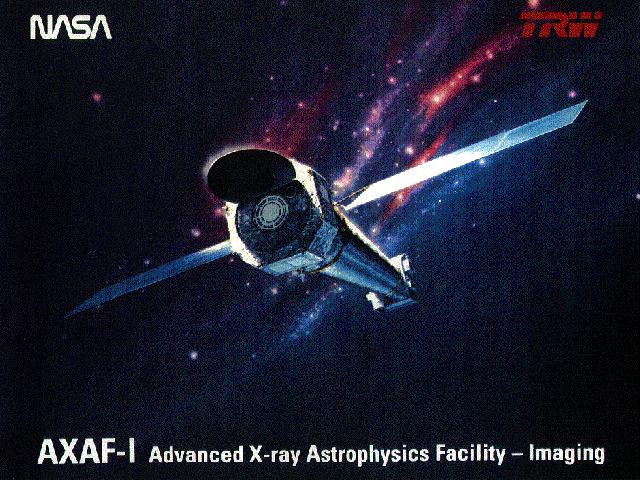 (1)
(1)
The AXAF-I mission will develop and place into orbit a telescope forcapturing high resolution images of X-ray sources. It will produce imagesmuch like those made in visible light with an optical telescope. AXAF-Iuses optics and detectors which are sensitive to X-rays to capture imagesof the astronomical phenomena that are characterized by the extreme conditionsin space.
The Technology
The observation of X-ray "images" will be made possible, in part, by AXAF-I's unique mirror construction. The mirror consists of four pairsof "nested" reflecting surfaces. The combination of high resolution, largecollecting area, and sensitivity to higher energy X-rays will make it possiblefor AXAF-I to study extremely faint sources, that might otherwise be absorbed,in crowded space. (1)
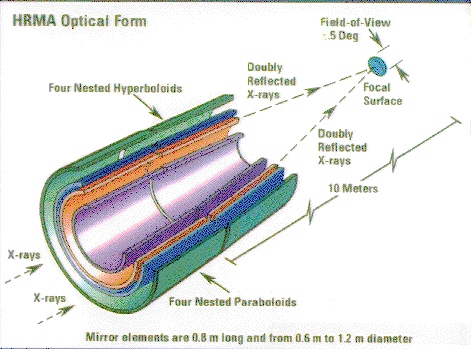 (1)
(1) 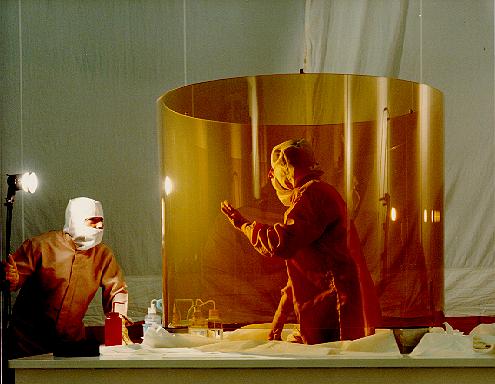
AXAF-I has a unique assembly of four cylindrical "grazing-incidence"mirrors, the mirrors are the largest ever built and the smoothest, polishedto the atom. (2) In an X-ray telescope, the mirrors are much differentfrom those in optical telescopes. X-ray telescopes use "grazing-incidence"mirrors - finely polished cylinders of glass that resemble ordinarydrinking glasses with no bottom. The walls of the cylinders are very slightlyangled so that X-rays graze off the surfaces, like a stone skipping ona pond. This configuration, coupled with a slight curvature of the surfaces,funnels the rays toward a point of focus behind the mirrors. (1) (Seepicture above, left.)
Optical vs. X-ray Telescopes
While there are many optical telescope designs, all optical telescopedesigns share some of the same features: a mirror that collects the lightand brings it to a focal point, and a separate lens called the eyepiecewhich allows visual examination of the image. In optical telescopes, theoptical components, such as lenses and mirrors, are used to control thepaths of light rays entering the telescope. The purpose of the lens ormirror is to bring the light rays from a point source (all stars are farenough away that they can be considered point sources of light) to a commonpoint in space, called the focal point. (10)
Optical Mirror System X-ray Mirror System
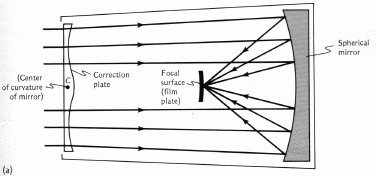 (10)
(10) 
The mirror system that is used in optical telescopes does not work forX-ray telescopes. X-rays are very short wavelengths that penetrate solidmatter. The electromagnetic spectrum explains this reasoning. As was previouslydocumented, the electromagnetic spectrum consists of the entire range ofelectromagnetic wavelengths. X-rays are electromagnetic radiation withwavelengths about a ten millionth of an inch in length. Wave lengths thatare visible light are "between about 16 and 32 millionths of an inch."(Hazen & Trefil, 51) In the human perspective this size differencemay not seem of great magnitude, but on the quantum level it is the differencebetween night and day. To further put this size difference in perspective,an X-ray wave length is approximately the length of an atom, whereas avisible light wave length is approximately the length of 5,000 atoms. Thisdifference in wavelength, and therefore difference in magnitude of energyradiation, are what delineate between an electromagnetic wave being absorbed,or being reflected by conventional telescopic mirror design.
X-rays are not reflected from the surface of the spherical mirror ofan optical telescope, they are absorbed. Therefore, X-ray telescopes usewhat are referred to as "grazing-incidence" mirrors to inhibit X-ray absorption.Once inside AXAF-I, X-rays will come in contact the four finely polishedcylindrical glass mirrors. Because the cylinders of glass are only slightlyangled, rather than absorbing the X-rays, the X-rays will bounce down thesurface of the mirrors, "like a stone skipping on a pond." The slight,yet extremely precise angle of the mirrors will direct the X-rays towardthe focal surface behind the mirrors. From the focal surface of the telescope,the X-ray image will then be studied and mapped in a number of ways. Astronomerscan use this information to detect black holes, measure galactic temperatures,map new high energy systems and solve some of the most violent mysteriesin the Universe.
Conclusion
Many of the brightest X-ray sources in our galaxy are the remnants of massive stars that have undergone a catastrophic collapse and have becomeblack holes. (9) AXAF-I is expected to detect black holes 100 times fainterthan NASA's previous X-ray telescope. AXAF-I observations will providea sample of distant objects which record the state of the universe in manyunique ways. The X-ray Universe is mysterious, somewhat unknown territory.X-ray observations performed by AXAF-I will aid Astronomers in better understandingspace, and the violent nature of black holes.
Relativity predicted black holes, and X-rays have shown us that theseblack holes do exist. AXAF-I will reveal X-ray images never before seenby humans, and bring us one step closer to understanding the mystery ofblack holes in the X-ray Universe.
1. Harvard University. NASA - The Advanced X-Ray Astrophysics Facility.AXAF Overview.
http://hea-www.harvard.edu/HRC/AXAF/AXAF.html
2. USA TODAY ONLINE - "NASA brings its X-Ray vision to the universe."10/23/97 .Tim Friend.
http://www.usatoday.com/life/science/space/lss095.htm
3. MIT Center for Space Research Online - ACIS FOCAL PLANE INSTRUMENTFOR THE AXAF-I SPACECRAFT
http://acis.mit.edu/acis/eb-paper/main.html
4. Smithsonian Astrophysical Observatory (SAO), HRC Project Online -The High Resolution Camera (HRC) on the
Advanced X-ray Astrophysics Facility (AXAF)
http://hea-www.harvard.edu/HRC/HomePage.html
5. Black Holes and Neutron Stars. Last updated on Mar. 4, 1997
http://w3.gti.net/cmmiller/BH/blkmain.html
6. Hazen, Robert M. and James Trefil. Science Matters.
Double Day. New York. 1991.
7. Hewitt. Conceptual Physical Science.
New York: HarperCollins, 1994.
8. Hawking, Stephen. A Brief History of Time: From the Big Bang to BlackHoles.
New York: Bantam Books, 1988.
9. Harvard University. Black Holes Online. Last Updated on 10/21/97
http://xrtpub.harvard.edu/Xray/black_holes.html
10. University of Pennsylvania. Telescope Components.
http://dept.physics.upenn.edu/~www/balloon/telescope.html
11. NASA Online. The Electromagnetic Spectrum. Last updated on 11/6/96
http://www.athena.ivv.nasa.gov/curric/space/lfs/emspectr.html